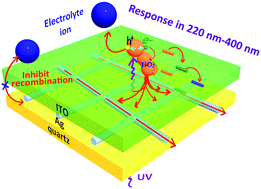Expansion of the response range of photoelectrochemical UV detector using an ITO/Ag-nanowire/quartz UV-visible transparent conductive electrode†
Abstract
The photoelectrochemical (PEC) UV detector based on the traditional transparent conductive electrode (TCE) has a narrow response range due to the UV filtering effect. Here we prepared an Ag nanowire network by electrospinning and magnetron sputtering, and then transferred it to a quartz substrate to obtain a UV-visible TCE, which exhibits high transmittance of 80% in the UV region, and a very small sheet resistance of about 2 Ω sq−1. An ITO functional layer is deposited to further improve the vertical electron conductivity and inhibit electronic recombination. After the photoactive layer was prepared by a sintering-free method, the PEC UV detector based on the new electrode system showed excellent self-powered response performance, including fast response, linear response and high sensitivity, and the response range of the device was greatly extended to 220–400 nm. Our work provides an effective strategy for solving the key problems of PEC UV detectors.



 Please wait while we load your content...
Please wait while we load your content...